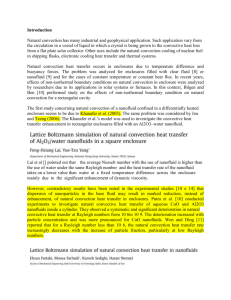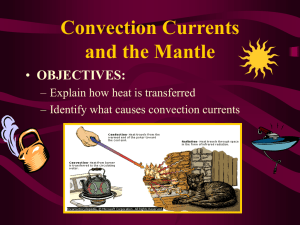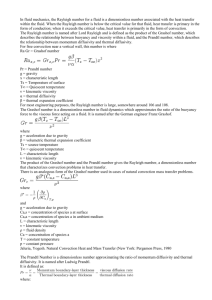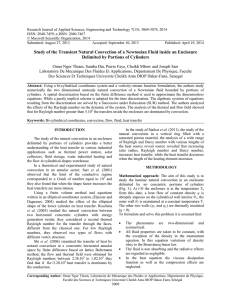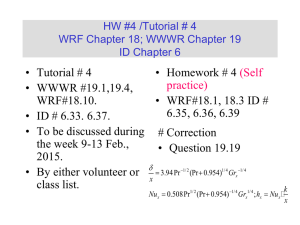template_ASCHT2015_full
advertisement
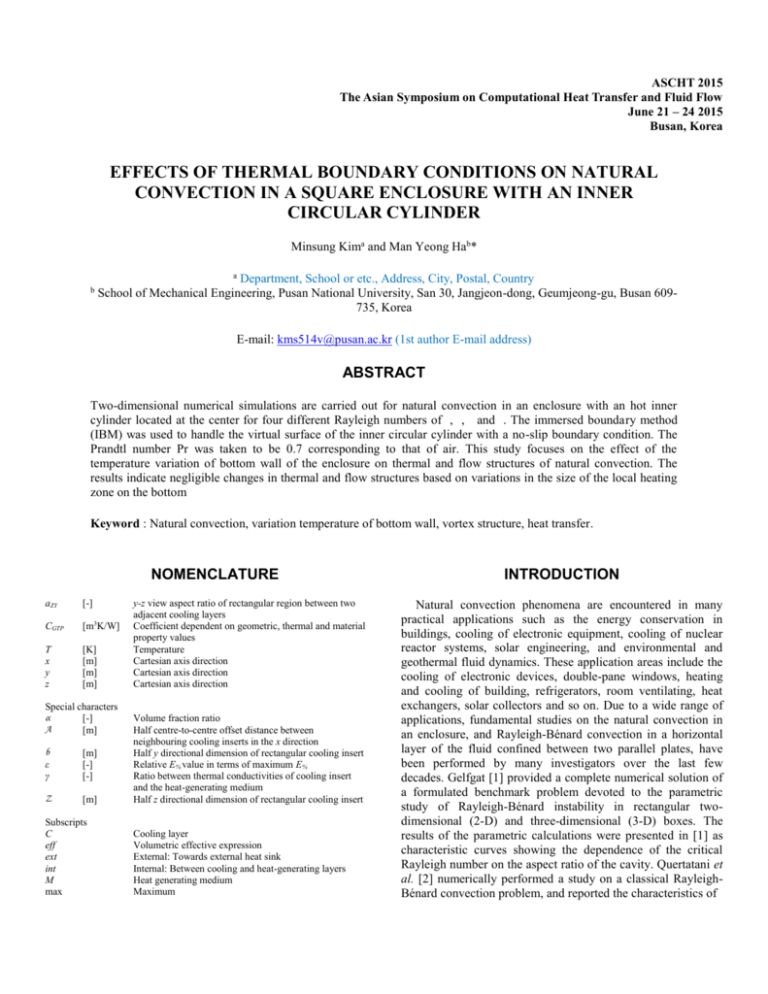
ASCHT 2015 The Asian Symposium on Computational Heat Transfer and Fluid Flow June 21 – 24 2015 Busan, Korea EFFECTS OF THERMAL BOUNDARY CONDITIONS ON NATURAL CONVECTION IN A SQUARE ENCLOSURE WITH AN INNER CIRCULAR CYLINDER Minsung Kima and Man Yeong Hab* a b Department, School or etc., Address, City, Postal, Country School of Mechanical Engineering, Pusan National University, San 30, Jangjeon-dong, Geumjeong-gu, Busan 609735, Korea E-mail: kms514v@pusan.ac.kr (1st author E-mail address) ABSTRACT Two-dimensional numerical simulations are carried out for natural convection in an enclosure with an hot inner cylinder located at the center for four different Rayleigh numbers of , , and . The immersed boundary method (IBM) was used to handle the virtual surface of the inner circular cylinder with a no-slip boundary condition. The Prandtl number Pr was taken to be 0.7 corresponding to that of air. This study focuses on the effect of the temperature variation of bottom wall of the enclosure on thermal and flow structures of natural convection. The results indicate negligible changes in thermal and flow structures based on variations in the size of the local heating zone on the bottom Keyword : Natural convection, variation temperature of bottom wall, vortex structure, heat transfer. NOMENCLATURE aZY [-] 3 CGTP [m K/W] T x y z [K] [m] [m] [m] Special characters α [-] A [m] b ε γ [m] [-] [-] Z [m] Subscripts C eff ext int M max y-z view aspect ratio of rectangular region between two adjacent cooling layers Coefficient dependent on geometric, thermal and material property values Temperature Cartesian axis direction Cartesian axis direction Cartesian axis direction Volume fraction ratio Half centre-to-centre offset distance between neighbouring cooling inserts in the x direction Half y directional dimension of rectangular cooling insert Relative E% value in terms of maximum E% Ratio between thermal conductivities of cooling insert and the heat-generating medium Half z directional dimension of rectangular cooling insert Cooling layer Volumetric effective expression External: Towards external heat sink Internal: Between cooling and heat-generating layers Heat generating medium Maximum INTRODUCTION Natural convection phenomena are encountered in many practical applications such as the energy conservation in buildings, cooling of electronic equipment, cooling of nuclear reactor systems, solar engineering, and environmental and geothermal fluid dynamics. These application areas include the cooling of electronic devices, double-pane windows, heating and cooling of building, refrigerators, room ventilating, heat exchangers, solar collectors and so on. Due to a wide range of applications, fundamental studies on the natural convection in an enclosure, and Rayleigh-Bénard convection in a horizontal layer of the fluid confined between two parallel plates, have been performed by many investigators over the last few decades. Gelfgat [1] provided a complete numerical solution of a formulated benchmark problem devoted to the parametric study of Rayleigh-Bénard instability in rectangular twodimensional (2-D) and three-dimensional (3-D) boxes. The results of the parametric calculations were presented in [1] as characteristic curves showing the dependence of the critical Rayleigh number on the aspect ratio of the cavity. Quertatani et al. [2] numerically performed a study on a classical RayleighBénard convection problem, and reported the characteristics of Table 1 Grid dependency test results for the surface-averaged Nusselt number around the inner cylinder Nucyl when NUMERICAL METHODOLOGY A schematic of the system is shown in Figure 1. The system consists of a square enclosure with sides of length L , within which a circular cylinder of radius R (= 0.2 L ) is located at the center. As shown in Figure 1, the top and side walls of the enclosure are kept at a constant low temperature Tc , whereas the bottom wall of the enclosure is kept at a constant temperature Tb whose value changes as a parameter in the present computation. The cylinder surface is kept at a constant high temperature Th . Ra 106 and b 0.0 . Grid number Nucyl 202 202 252 252 302 302 352 352 402 402 4.9921 4.9902 4.9978 4.9998 5.0009 Difference (%) 0.18 0.21 0.06 0.02 - RESULTS AND DISCUSSION Figure 3 shows the distribution of isotherms and streamlines in the enclosure for the case of b 0.0 for different Rayleigh Figure 1 Computational domain and coordinate system along with boundary conditions The governing equations describing unsteady incompressible viscous fluid flow and thermal fields are the continuity, momentum, and energy conservation equations in their non-dimensional forms, which are defined as ui q 0 xi (1) ui u 2ui P uj i Pr RaPri 2 fi (2) t x j xi x j x j 2 uj h t x j x j x j (3) where the dimensionless variables in equations (1)-(3) are defined as follows: t T * Tc* xi* t * P* L2 ui* L x , , , , P u i i L L2 2 Th* Tc* (4) In equation (4), the superscript (*) denotes the dimensional variables; and represent the density and the thermal diffusivity of the fluid, respectively; P , , and t represent the dimensionless pressure, the dimensionless temperature, and the dimensionless time, respectively; xi represents the dimensionless Cartesian coordinates; and ui represents the numbers of Ra 103 , 104 , 105 and 106 . The flow and thermal fields eventually reached the steady state for all simulation cases at four different Rayleigh numbers considered. In terms of general fluid motion occurring due to natural convection as shown in Figure 3, the heated lighter fluid is lifted along the hot surface of the inner cylinder due to buoyancy as a driving force. As the fluid flow approaches the cold top wall of the enclosure, it becomes gradually colder and denser. The fluid cools further as it moves along the cold top wall in the lateral direction. Finally, a denser fluid cooled moves downward along the cold side walls of the enclosure. Thus, the main circulation of the convection flow is formed in the enclosure. CONCLUSIONS Two-dimensional numerical simulations were performed for natural convection in a square enclosure with an hot inner cylinder for four different Rayleigh numbers of 103 , 104 , 105 and 106 , by using the immersed boundary method to provide an in-depth analysis of various phenomena associated with natural convection such as the formation of the vortex structure and the corresponding heat transfer based on the various temperature conditions of bottom wall. When Ra 103 and Ra 104 , variations in the value of the bottom temperature have little effect on thermal and flow structures, although there are small variations in the convection velocity in the enclosure. Consequently, there is a little difference in the overall heat transfer capacity in terms of the Nusselt number between the top wall and the cylinder surface based on variations b . A primary vortex pair showing a mirror symmetric pattern at Ra 103 and Ra 104 . For the cases of Ra 103 , the temperature variation of the bottom. ACKNOWLEDGEMENT This research was supported by ABCDE of National Research Foundation of Korea(NRF). REFERENCES [1] Van Wyk J.D., Strydom J.T., Zhao L., and Chen R., Review of the development of high density integrated technology for electromagnetic power passives, Proceedings of the 2nd International Conference on Integrated Power Systems (CIPS), 2002, pp. 25-34 [2] Strydom, J.T., and Van Wyk, J.D., Electromagnetic design optimisation of planar integreted passive modules, Proceedings of the 33rd I.E.E.E. Power Electronics Specialist Conference (PESC), Australia, Vol. 2, June 2002, pp. 573-578 [3] Strydom, J.T., Van Wyk, J.D., and Ferreira, J.A., Some units of integrated L-C-T modules at 1MHz, I.E.E.E Transactions on Industry Applications, Vol. 37, No. 3, May/June 2001, pp. 820-828 [4] Dirker, J., Liu, W., Van Wyk, J.D., Meyer, J.P., and Malan, A.G., Embedded solid state heat extraction in integrated power electronic modules, Accepted for publication in the I.E.E.E. Transactions on Power Electronics, vol. 20, No. 3, May 2005. [5] Almogbel M., and Bejan A., Conduction trees with spacing at tips, International Journal of Heat and Mass Transfer, Vol. 42, 1999, pp. 3739-3756 [6] Bejan A., and Almogbel M., Constructal T-shaped fins, International Journal of Heat and Mass Transfer, Vol. 43, 2000, pp. 2101-2115 [7] Almogbel M., and Bejan A., Cylindrical trees of pin fins, International Journal of Heat and Mass Transfer, Vol. 43, 2000, pp. 4285-4297
